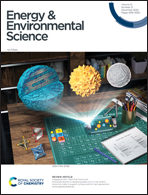Quantification of water transport in a CO2 electrolyzer†
Abstract
A sufficient supply of water at the catalyst layer is needed to mediate the CO2 reduction reaction (CO2RR), yet too much water favours the competing hydrogen evolution reaction (HER) and lowers the efficiency of CO2 electrolysis. It is therefore important to quantify water at the cathode, but CO2 electrolyzers are typically enclosed systems where only the inputs and outputs can be readily measured. We report herein an analytical CO2RR electrolyzer with sensors in the cathode chamber to directly measure the relative humidity (RH) and temperature during electrolysis. These measurements enable the flow of water to be tracked inside the flow cell, and provide the boundary conditions necessary for a 3D model of mass transport and fluid flow in the cathode chamber. We developed a 3D model which showed that the molar fraction of water at the cathodic GDE/membrane interface, xH2O,mem, is constant under a range of applied current densities (25–200 mA cm−2) and CO2 flow rates (25–200 sccm), and does not change as a function of humidification of the CO2 feed. The value of xH2O,mem is held at parity because more water is drawn across the membrane (from the liquid-fed anode) when insufficient water is supplied to the cathode from the CO2 feed. This result points to a higher flux of water across the membrane when using drier CO2 feedstocks at higher flow rates and higher current densities. Consequently, undesirable anolyte crossover (which causes salt precipitation at the cathode) can be suppressed by maintaining a humidified CO2 feed. This 3D model can be used for a range of operating conditions, materials, and flow fields to help with CO2RR electrolyzer design and optimization.



 Please wait while we load your content...
Please wait while we load your content...